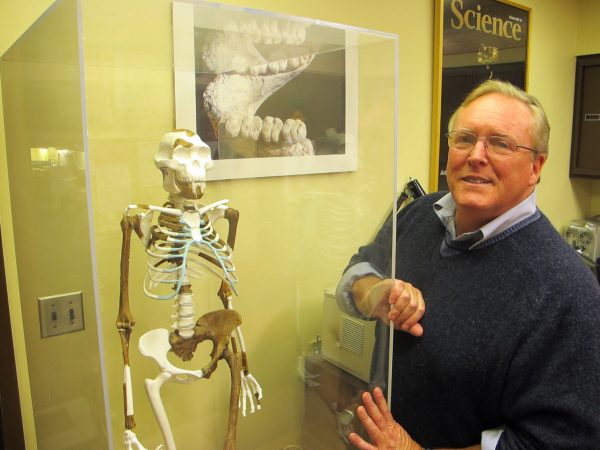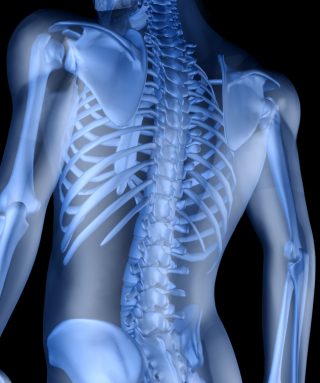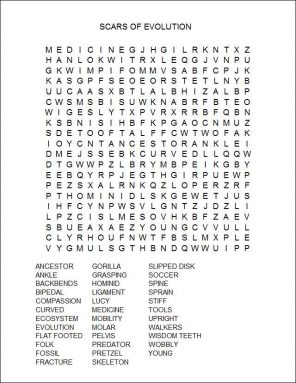Many human ails are ‘scars’ of evolution
Blame evolution for why sprained ankles, hip fractures and other physical problems plague people — and not our closest animal relatives

Backaches can be brought on by overexerting yourself when exercising. But evolution is also responsible for some of the pain. Scientists say that the transition from walking on four feet to standing on two can play a role in everything from sore feet to sprained ankles and backaches.
Yuri/iStockphoto
By Susan Gaidos
Sometimes it just happens: Step off a curb or walk over a rocky surface and suddenly your ankle twists. At once, your arms flail and your body jerks as you strain to catch your balance. Such trip-ups can be painful and embarrassing. But often the culprit is not clumsiness.
It’s evolution.
Traveling upright — on two feet — “is a very peculiar way to walk,” notes Bruce Latimer of Case Western Reserve University in Cleveland, Ohio. “No other mammal does it.”
Latimer should know. An anthropologist, he studies fossils and teaches medicine. He also travels the world hunting fossils and poring over the skeletal remains of humanity’s earliest ancestors.

As our pre-human ancestors evolved, many of these hominids, as they’re called, began to walk on two feet instead of four. This freed up their hands to make tools, to hunt and to carry their young. But those advantages came at a price. Walking upright put new stresses on the legs, feet and back. Flat feet, sprained ankles and slipped disks all trace back to moving around on two feet, not four, Latimer explains.
Here we meet three scientists who study the aches and breaks suffered by humans — and none of our primate relatives. These particularly human maladies all stem directly from our becoming bipeds: two-footed, upright walkers. Their findings point out that for all its advantages, this adaptation has required some painful compromises.
Evolution isn’t perfect
When looking at fossil remains, Latimer says it’s easy to tell apart the ancestors of apes and humans. That’s because being able to stand on two feet — much less walk and run — required a massive number of changes. And they show up throughout the skeleton.
“In order to walk upright, you have to change essentially every bone from the neck down,” Latimer explains.
Evolution is, simply, change over time. Usually, it occurs in small, gradual steps. Over millions of years, changes can help an organism adapt to its environment. Individuals that carry those changes will tend to survive and out-compete others of their species. Those that don’t will compete less well and lose out. Better-adapted individuals also will tend to reproduce more. This allows them to pass down their altered genes that help the next generation as well. Over time, these better-adapted organisms make up a larger and larger share of their species.

So it was with the adaptation to walking on two feet. Upright walking is considered one of the earliest and most important steps that our species took in becoming human. It is natural then to ask why it leads to pain in so many people today.
For all its adaptive advantages, evolution does not produce perfection, explains anthropologist Jeremy DeSilva, of Boston University. And that makes sense, he adds. Rather than starting from scratch to build a body made for hiking and running, evolution instead works with the genes and traits at hand to reshape a species. In our case, that meant transforming an ancient ape’s body, designed for living in trees, into a human body more at home on the ground.
Natural selection has done a good job in this conversion, say scientists who study evolution, such as Karen Rosenberg of the University of Delaware in Newark. It’s good enough to have helped humans survive and ultimately dominate their ecosystem. But it’s not so good that we don’t also suffer some consequences.
One way to understand the aches and pains that people suffer today is to look at what makes upright walking possible.
Take a stand
People are primates. That means we are related to apes, monkeys and a host of other tree-dwelling primates. Scientists believe that our ancestorssplit from the ancestors of chimpanzees between 5 million and 10 million years ago. Between 4 million and 5 million years ago, these pre-humans — the line of folk who eventually evolved into people — mastered the ability to walk upright. But they couldn’t do it by will alone. Their skeleton and the tissues that hold those bones together also had to slowly morph.

One of the most famous hominid fossils is the incomplete skeleton of an individual nicknamed Lucy. Scientists discovered her remains in East Africa nearly 40 years ago. A possible human ancestor who lived about 3 million years ago, Lucy belonged to the species Australopithecus afarensis (Aw STRAL oh PITH eh kus AF ar EN sis).
She walked upright like a human. Still, she had some chimplike traits. Her neck joined farther toward the back of her skull than it does in modern people. Her brain was smaller than a human’s as well.
But Lucy’s swinging arms and flexible ankles gave her a humanlike stride. She had another distinctive human trait: Lucy’s lower spine curved inward. Known as the lumbar curve, it is found only in people and some hominid ancestors.
Today, humans have two additional curves to their spine: one in the upper thorax, or chest, and another in the neck.All that curving gives the spine an “S” shape and helps balance the trunk and head over our hips and feet.
Chimps lack those extra curves, Latimer says. Instead, their backs evolved to be stiff. That gives them an advantage in climbing and moving through trees. To keep their spines stable, a chimp’s back is locked up with strong, elastic bands of tissue — called ligaments. (A ligament connects bones to other bones.)
Adding curves to the spine gave humans all sorts of extra mobility, Latimer explains. “We can twist, bend forward or do backbends.” So gymnastics fans take note: There would be no Olympic-style pretzel-twisting contortions without our curves.
Back pain: One bipedal trade-off
For all of the advantages to upright walking, the extra curve in the lumbar area can lead to pain there. In fact, backache ranks as one of the top human ailments, Latimer says. Football players, swimmers and gymnasts are particularly vulnerable.
Humanity’s back adaptations can trigger other problems as well.

The human spine contains 33 bones called vertebrae. (Each single vertebra creates a bump that you can feel through the skin down the center of your back). The way vertebrae stack one atop the other allows people to stand tall. To keep these bones from rubbing against one another, a cushioning tissue, called a disk, sits between each vertebra. Those disks act like shock absorbers: When you jump, lean or bend over, they should squish a bit to keep those back bones from rubbing.
But after years of such motion, disks can wear out or deform. With each step, Latimer explains, theupper body moves in one direction as the lower body twists a bit in the opposite direction. This twisting can cause a disk to move out of position. When it does, this cushiony disk, now called a “slipped” or “herniated” disk, can compress adjacent nerves as it deforms. The result: excruciating pain in the back or leg.
Human vertebrae are larger than those in apes. That helps stabilize our spines so we can stand and walk upright. But there’s a hitch. While bigger, our vertebrae are actually weaker than an ape’s. Explains Latimer: “During evolutionary change, humans took the same amount of bone mass that a chimpanzee or gorilla has, and spread it over a larger area.”
This made the bones in our backs less dense and less strong. It also means that as people approach middle or old age, those vertebrae can begin to give out, Latimer says.These bones, as well as others, often weaken and become brittle. (Another common injury in the elderly, hip fractures, also can be traced to the loss in bone mass.)
Our feet: Too many bones!
Weak and wobbly spines are one thing, but a lot more happens when you remodel an apelike foot into a human’s. Just ask DeSilva. Clearly, he says, “If you really want to understand how humans learned to walk, the foot is a good place to start.”
Yet few foot bones from ancient hominids are known to exist. That is because few survive as fossils. Sharp-toothed predators often ate their victims’ hands and feet. If not devoured, the tiny bones in these body parts might have gotten lost in the ground.

“If you see a fossil jaw or skull, you’re never going to mistake it for a rock,” DeSilva says. “But a tiny little foot bone? You might.”
Still, scientists have found a few intact fossil feet. DeSilva has been using those fossils to piece together a picture of how ancient primates evolved, from tree climbers to upright walkers. His studies also have been helping scientists understand foot problems faced by people today — and our hominid ancestors long ago.
Chimpanzees, gorillas and other primates have 52 foot bones, or 26 in each foot. They need all these to maintain the flexibility needed for a foot to grasp well and climb.
Strolling around on two legs requires more stability. So over millions of years, evolution slowly converted a mobile, grasping foot into a stiff and rigid one. That didn’t require 26 bones. In fact, 26 are way too many, DeSilva argues. To cope, the hominid body adapted by altering the angle of a bone here. Or it turned a curved bone into a flat one somewhere else. Most of those changes were quite subtle, the scientist observes.
Another change: Over time, some foot tissue thickened to form a ligament. Called the anterior talofibular ligament, it resembles an elastic band. This ligament holds bones together at the ankle. The extra stability it offers helps people walk on two feet.
But this solution has proven far from ideal. When people step the wrong way, the foot may twist to the side. This can cause a sprain. The problem plagues athletes in many sports, especially basketball and soccer.In fact, the anterior talofibular is the most-often sprained ligament in the entire body, DeSilva notes. It’s a problem chimps will never experience — because they don’t have this tissue. In fact, having this ligament would make it hard to twist in ways needed to support their climbing.
So a sprained ankle is now a common problem. But it’s hardly a new one. Fossils show that even millions of years ago, ankle sprains and breaks plagued some hominid ancestors, DeSilva says.
Other foot problems trace to far more modern habits, such as wearing shoes. When laced up in shoes, foot muscles don’t need to work as hard as they do when our feet are bared. Over time, shoed feet may lose their power. Then, when someone walks barefoot or stresses the feet, a stiff and painful condition can result. It’s known as collapsed arches.
Even Lucy suffered foot ailments. Scientists had long noticed that she had a peculiar angle to her ankle. In 2010, DeSilva and a coworker took a close look at it. They compared the angle of her ankle to that of 250 modern-day humans.
This showed that even today some people have the same “tilting” ankle seen in Lucy. All of these people were born flat-footed. That means their feet never developed an arch. DeSilva and his coworkers now conclude that Lucy apparently was flat-footed too.
Pains, brains and gains
As humans evolved, theirbrains also enlarged and became more complex. Over the course of human evolution, the brain tripled in size. To make room for this extra tissue, the shape of the face and head changed over time as well. Weird as it may sound, these changes left less room for some teeth.

Known as wisdom teeth, these molars emerge at the back of the mouth, often near the end of adolescence. Early hominids relied on this spare set of molars to substitute for teeth that had been worn down by chewing a diet of roots and nuts. Humans no longer need these bonus teeth. In fact, wisdom teeth can prove a nuisance. If the jaw lacks room for them to grow in properly, intense pain or an infection can develop. That’s why dentists often remove these extra teeth.
But it wasn’t just the human brain and skull that changed in size and shape. As bodies adapted to upright walking and bigger brains, females’ bodies changed to make room for their large-brained babies. Compared with the newborns of other primates, human babies are very big, notes Rosenberg. A paleoanthropologist, she studies our near-human ancestors.
“Although they may seem tiny to first-time parents, human newborn babies are actually big, relative to their mothers,” she observes. For instance, newborn gorillas, on average, are only 2.7 percent as big as their mothers. Chimps, at birth, are 3.3 percent of their mother’s size. Human babies? They’re a whopping 6.1 percent as big as their moms.
To accommodate larger babies, a woman’s pelvis had to widen and deepen. The birth canal also changed shape. In chimps and other nonhuman primates, the oval-shaped birth canal is broad and flat from beginning to end. This allows a baby chimp to shoot through the canal in a straight shot at birth.
In people, the birth canal is different. It starts out broad and flat. Then, halfway down, it narrows and lengthens. To exit through this birth canal, human babies must turn along the way, rotating 90 degrees.

This rotation makes it possible for moms to push large babies through their pelvis as they give birth. But it also makes it harder for them to give birth without help from others.
This change easily might have lead to disaster, Rosenberg says. After all, “other primates generally give birth without assistance.”
But rather than viewing it as a flaw, Rosenberg says this evolutionary trade-off may have led to a gain. For humanity to survive, people had to find ways to help women give birth. Such acts may have fostered more compassion and care — and a greater sense of community.
DeSilva agrees. Even in Lucy’s day, individuals who suffered ankle sprains or breaks managed to survive. Scientists know this because they have identified healed bone injuries in some fossilized remains. Chances are that the injured individuals needed help from others — and received it.
There’s no proof this happened, he cautions. But he says that is a logical explanation for why certain fossils bear these types of healed injuries.
Indeed, ancient pre-humans, such as Lucy, faced numerous challenges from their environment, including big-toothed predators.
But the development of communities that help each other could improve the survival rates of all bipedal folk. After all, “Once you start walking on two legs, you can’t gallop anymore,” DeSilva explains. “We’re a slow, slow species.”
Power Words
adaptation A process by which an organism or species becomes better suited to its environment. When a community of organisms does this over time, scientists refer to the change as evolution.
anthropology The study of humankind.
biped (adj. bipedal) Having two feet or walking on two feet.
evolve To change gradually over generations or over a long period of time.
fossil Any preserved remains, footprints or traces of ancient life.
hominid A human or primate species (known from fossil remains) that gave way to humans and their ancient bipedal kin.
ligament A band of strong, tough tissue that joins bones.
natural selection The evolutionary process by which organisms best adapted to their environment tend to survive and pass on their genetic characteristics to future generations, while those less adapted to their environment tend to be eliminated.
paleo A prefix that means associated with ancient times.
pelvis The part of the skeleton that joins the spine to the lower limbs. The primate pelvis is shaped like a basin and contains two hip bones.
primate Any member of the order of animals that includes apes, monkeys and humans.
thorax Part of the human body between the neck and the diaphragm.
sprain (in medicine) A painful injury to a joint that can cause bruising and swelling.
Word find (click here to enlarge for printing)








